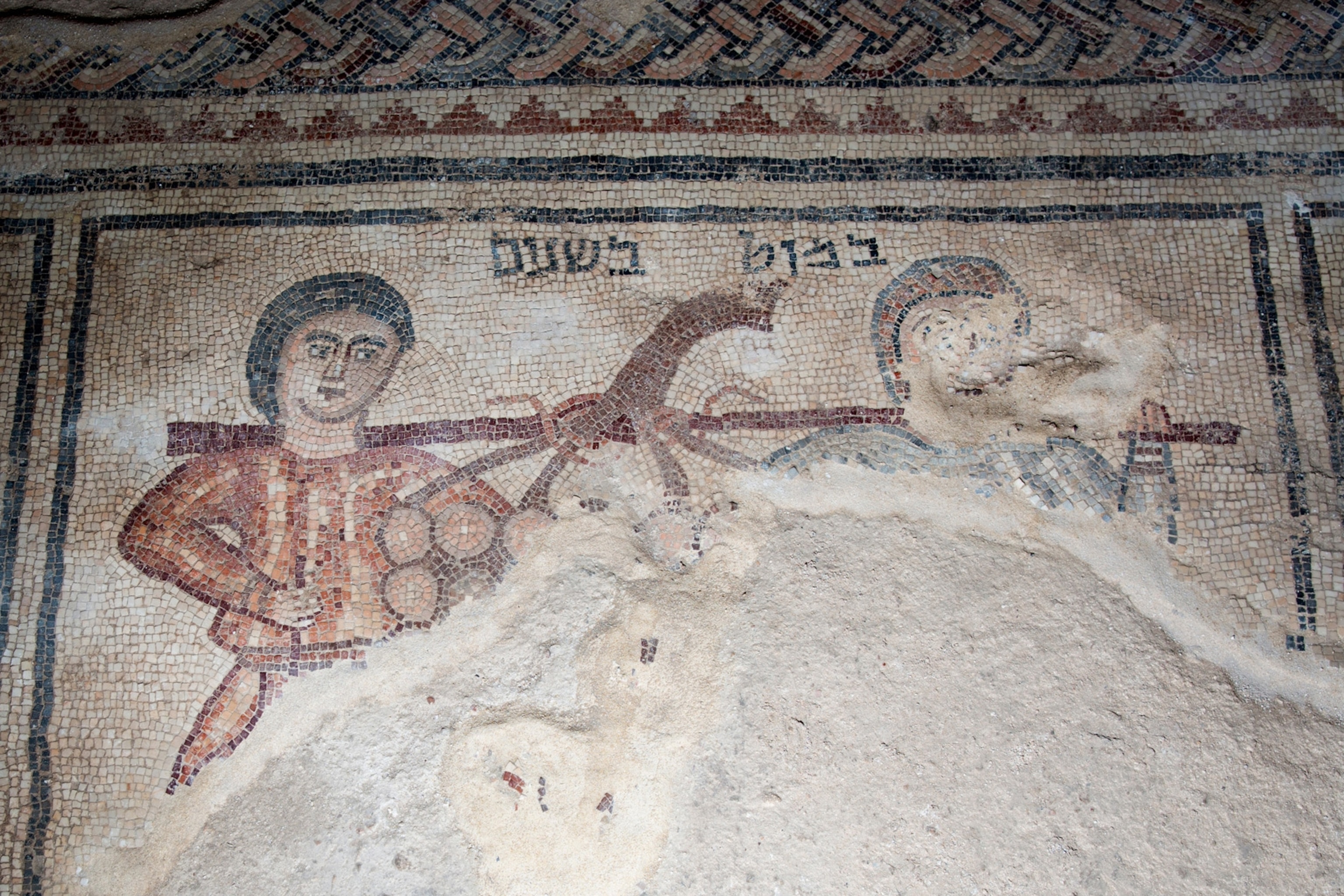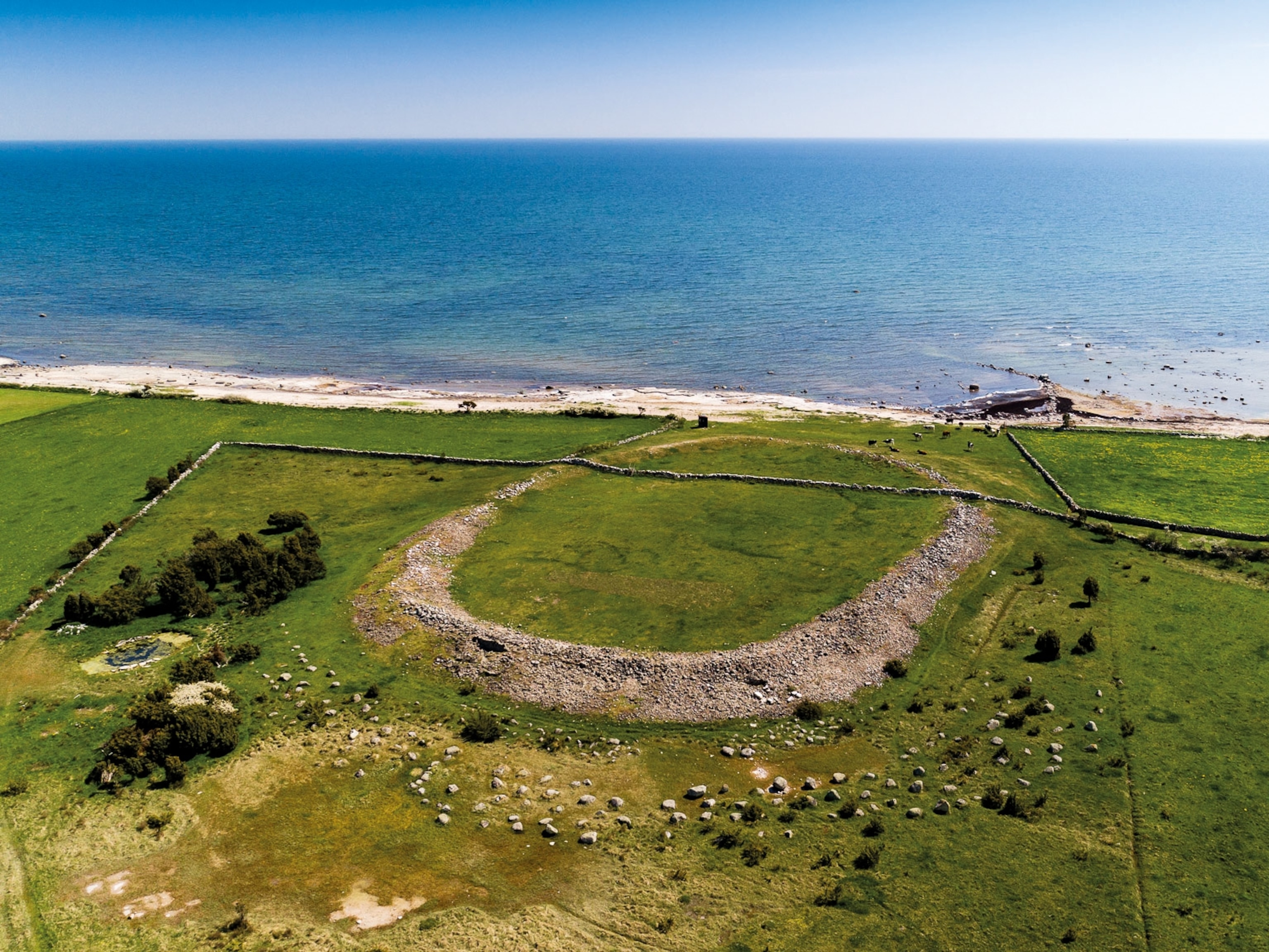Noah's ark, the splitting of the Red Sea, perhaps even a visit from Alexander the Great: Since 2012, these colorful scenes have slowly emerged as archaeologists excavate the elaborate mosaic floor of a 1,500-year-old synagogue in Israel's Lower Galilee region.
The latest scene-stealer? Moses' spies.
The mosaic scene, which depicts two men carrying a pole laden with grapes, was recently discovered during the ongoing investigations at Huqoq, the site of the synagogue excavation, according a release issued today by the University of North Carolina-Chapel Hill. An inscription in Hebrew above the men reads “a pole between two”—a reference to the biblical passage Numbers 13:23.
In the Book of Numbers, Moses sends scouts up into the land of Canaan following the Exodus from Egypt. The spies returned with tales of an abundant land of milk and honey—with bunches of grapes so large they required two men to carry. Most of the scouts, however, were uncertain that they could conquer Canaan and wandered in the wilderness for 40 years as a result.

The “unparalleled” finds at Huqoq contradict the idea that Jewish settlements in Galilee suffered as the influence of Christianity grew in the region, says archaeologist Jodi Magness, director of the Huqoq excavations. Not only is the artwork in the synagogue of exceptional quality, but it also highlights a rich visual culture at a time when Jewish art is believed to have shunned images.
The Huqoq mosaics, which have been excavated with support from the National Geographic Society, even contain a nonbiblical scene that Magness believes represents a fabled visit to the region by Alexander the Great.
“This just enriches what we know about Judaism in late antiquity—how vibrant and dynamic and diverse it is,” she says.
While excavations at Huqoq will continue in 2019, Magness is reluctant to speculate what may be uncovered next: “I can't say what we expect to find, because everything we're finding is unexpected.”
Related Topics
You May Also Like
Go Further
Animals
- Octopuses have a lot of secrets. Can you guess 8 of them?
- Animals
- Feature
Octopuses have a lot of secrets. Can you guess 8 of them? - This biologist and her rescue dog help protect bears in the AndesThis biologist and her rescue dog help protect bears in the Andes
- An octopus invited this writer into her tank—and her secret worldAn octopus invited this writer into her tank—and her secret world
- Peace-loving bonobos are more aggressive than we thoughtPeace-loving bonobos are more aggressive than we thought
Environment
- This ancient society tried to stop El Niño—with child sacrificeThis ancient society tried to stop El Niño—with child sacrifice
- U.S. plans to clean its drinking water. What does that mean?U.S. plans to clean its drinking water. What does that mean?
- Food systems: supporting the triangle of food security, Video Story
- Paid Content
Food systems: supporting the triangle of food security - Will we ever solve the mystery of the Mima mounds?Will we ever solve the mystery of the Mima mounds?
- Are synthetic diamonds really better for the planet?Are synthetic diamonds really better for the planet?
- This year's cherry blossom peak bloom was a warning signThis year's cherry blossom peak bloom was a warning sign
History & Culture
- Strange clues in a Maya temple reveal a fiery political dramaStrange clues in a Maya temple reveal a fiery political drama
- How technology is revealing secrets in these ancient scrollsHow technology is revealing secrets in these ancient scrolls
- Pilgrimages aren’t just spiritual anymore. They’re a workout.Pilgrimages aren’t just spiritual anymore. They’re a workout.
- This ancient society tried to stop El Niño—with child sacrificeThis ancient society tried to stop El Niño—with child sacrifice
- This ancient cure was just revived in a lab. Does it work?This ancient cure was just revived in a lab. Does it work?
- See how ancient Indigenous artists left their markSee how ancient Indigenous artists left their mark
Science
- This 80-foot-long sea monster was the killer whale of its timeThis 80-foot-long sea monster was the killer whale of its time
- Every 80 years, this star appears in the sky—and it’s almost timeEvery 80 years, this star appears in the sky—and it’s almost time
- How do you create your own ‘Blue Zone’? Here are 6 tipsHow do you create your own ‘Blue Zone’? Here are 6 tips
- Why outdoor adventure is important for women as they ageWhy outdoor adventure is important for women as they age
Travel
- Slow-roasted meats and fluffy dumplings in the Czech capitalSlow-roasted meats and fluffy dumplings in the Czech capital
- Want to travel like a local? Sleep in a Mongolian yurt or an Amish farmhouseWant to travel like a local? Sleep in a Mongolian yurt or an Amish farmhouse
- Sharing culinary traditions in the orchard-filled highlands of JordanSharing culinary traditions in the orchard-filled highlands of Jordan




